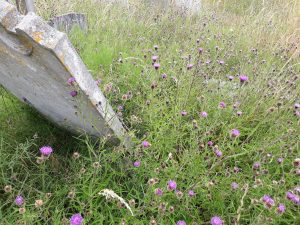Big Butterfly Count at Ryde Cemetery
On Wednesday 29th July, I set off in brilliant sunshine for a lunchtime visit to Ryde Cemetery so that I could carry out a walk for the Big Butterfly Count. This is an annual event run by Butterfly Conservation and the aim is to record as many of the commonest species as possible in the course of 15 minutes.
Needless to say, as soon as I had parked the car the sun went in, never to re-appear for the duration of the walk. That will have lowered the number of individual butterflies seen, and may have reduced the number of species too. Still, six species of butterfly were found, the majority being in the conservation area where the grass is allowed to grow tall. This year there was not the fire hazard that there has been in some recent years, and so there was no early cut, and the advantage of that, in terms of the number of butterflies seen, was very clear.

Knapweed
The commonest species by far was the gatekeeper or hedge brown, with at least 38 individuals counted. They are particularly fond of bramble bushes, and are usually the commonest species in this sort of habitat at this time of year. There was a single meadow brown, which is a little larger and slightly duller. The second commonest species was the marbled white, an attractive strongly patterned black and white butterfly, and at least five of these were seen. Nationally the commonest species to be recorded is the large white and the cemetery had two of these, in the more open areas where there was shorter grass. There were also a couple of small whites. The best find during the count was a wall brown. This is an attractively chequered orange and brown butterfly which likes bare ground which acts as a sun trap. One was seen, basking on a dried-up ant hill which clearly provided the necessary heat. As this species is not so common it is not on the list of butterflies that can be recorded as part of the count. They are not rare on the Isle of Wight, but the Isle of Wight is fortunate in that its populations are faring better than they are in many parts of the country.
The other great joy of the walk was the wonderful display of knapweed. It may be common but its purple flowers are a wonderful sight, and extremely good for butterflies like the marbled white.
So, the final tally was 49 individual butterflies of six species, if only I had tried one butterfly harder!
I know that no-one is competitive, but this was an interesting contrast with Newport Cemetery. There on a sunny day, I saw seven species (but only 24 individual butterflies) in a walk at the same time of day and of similar duration. It may be the extent of the uncut grass that is the crucial difference between the two.
As is always the case other species emerged as soon as the official counting stopped. There were a couple of blues but I did not have a good enough view of them to make an identification. What was really pleasing was to see a clouded yellow. These beautiful butterflies are migratory. Some years they arrive in good numbers, on other years there are few about. In contrast to the vivid buttercup yellow of the brimstone, the clouded yellow has a slightly more yellow-orange colour to it, more like the colour of a clementine. They may be worthwhile looking out for in your own garden as well as in the cemetery.
The Count was kindly carried out by Richard Smout, RSHG President.

